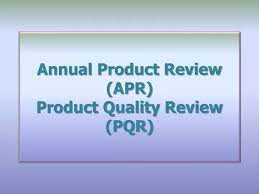Annual Product Quality Review (APQR/APR/PQR) in Quality Improvements

Annual Product Quality Review (APQR/APR/PQR) in Quality Improvements
1. What is APQR/APR/PQR?
-
Annual Product Quality Review (APQR), also known as Annual Product Review (APR) or Product Quality Review (PQR), is a regulatory requirement under ICH Q7, EU GMP Chapter 1 & 4, and FDA 21 CFR 211.180(e).
-
It is a systematic, documented evaluation of a drug product’s quality, consistency, and manufacturing processes conducted once a year for each product.
2. Objectives of APQR
-
To verify process consistency and identify trends.
-
To ensure product remains within specifications, quality standards, and regulatory filings.
-
To detect areas for improvement in manufacturing, testing, and controls.
-
To evaluate the effectiveness of CAPA, deviations, and change controls.
-
To support continuous improvement and lifecycle management.
3. Key Elements of APQR
A comprehensive APQR should include:
-
Product Quality Data: Batch records, in-process and finished product results, OOS/OOT, deviations.
-
Raw Material Review: Supplier performance, quality of APIs, excipients, and packaging materials.
-
Equipment & Facility Performance: Calibration, qualification, preventive maintenance, downtime trends.
-
Process Validation & Changes: Re-validation needs, technology transfer, process modifications.
-
Stability Studies: Review of stability data, shelf-life trends, and any stability failures.
-
Complaints & Recalls: Customer complaints, market complaints, returns, recalls.
-
Regulatory Commitments: Compliance with filed specifications and submissions.
-
CAPA & Deviations: Effectiveness checks, recurrence trends.
4. Role in Quality Improvements
-
Trend Analysis: Identifies recurring deviations, shifts in process capability, or raw material variability.
-
Preventive Actions: Provides data for proactive CAPA, reducing risks before they impact patients.
-
Supplier Qualification: Highlights consistent supplier issues → leads to supplier improvement or change.
-
Process Optimization: Detects inefficiencies in equipment, manufacturing, or testing processes.
-
Regulatory Compliance: Demonstrates to regulators a robust pharmaceutical quality system (PQS).
-
Lifecycle Management: Aligns with ICH Q10 for continual improvement of products and processes.
5. Benefits of Effective APQR Implementation
-
Strengthens data-driven decision-making.
-
Improves batch-to-batch consistency.
-
Reduces regulatory findings during inspections.
-
Enhances patient safety and product quality.
-
Supports cost efficiency by identifying waste or inefficiencies.
✅ Key Takeaway:
APQR/APR/PQR is more than a regulatory requirement—it is a powerful quality improvement tool that provides insights into product performance, identifies risks, and drives continuous improvement in pharmaceutical manufacturing.
🎓 Discover one of the best Complete Pharmaceutical Quality Assurance Course available —click below to explore the course that’s shaping future in QA Course skills.

